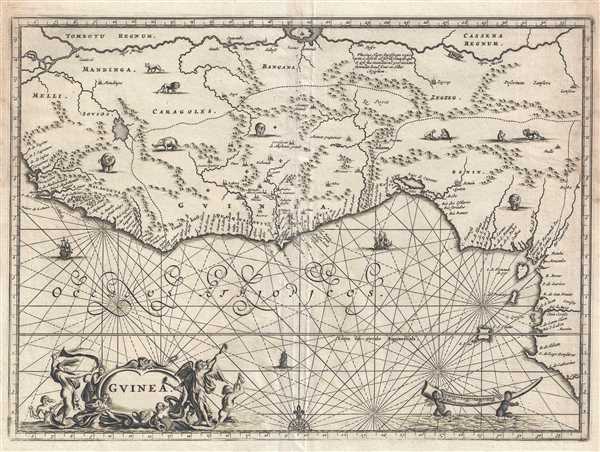This is a 1686 Olfert Dapper map of West Africa. The map depicts the region from approximately Mali and Sierra Leone along the Gulf of Guinea to Nigeria and Cameroon and from Mali and Niger to the Gulf of Gunea. Highly detailed, numerous locations are labeled along the coast, while cities and towns dot the interior, usually along one of the rivers. The Niger River flows across the top of the map and several others flow into the Gulf of Guinea, one of which is labeled as the Cameroon River. The modern-day country names of Guinea, Sierra Leone, and Benin are present, along with the 'Gold Coast,' then a British colony, which, following its independence has been known as Ghana. Several vignettes of African animals are included as well, including elephants, lions, a crocodile, and a pair of monkeys. Two ships appear off the coast on their way to India or to purchase West African slaves. At this point in history, the transatlantic slave trade was picking up steam, particularly with Portuguese traders. The Portuguese, who viewed this part of Africa as their property, would take their newly-purchased captives to the West Indies or Brazil. West Africa was at the center of the transatlantic slave trade at this point in history.
This map was produced by Olfert Dapper and published by in the French edition of Description of Africa entitled Description de L'Afrique and published in 1686.
Cartographer
Olfert Dapper (1636 - December 29, 1689) was a Dutch geographer, polyglot, and historian. Born in Amsterdam, he attended the University of Utrecht, where he was registered as a student in 1658. Two years later he began signing doctor medicinæ, but there in no evidence that he ever received any medical training or education. Dapper published a five-volume book about the history of Amsterdam entitled, Historische Beschrijving der Stadt Amsterdam and in 1665 published a Dutch translation from the Greek of the Histories of Herodotus. His best-known work, Naukeurige Beschrijvingen der Afrikaensche gewesten (Description of Africa), was published in 1668 and subsequently published in English by John Ogilby in 1670 and in French in 1686. Although Dapper never traveled to Africa, he took advantage of numerous reports from adventurers in order to compile this authoritative work over the course of three years. More by this mapmaker...
Source
Dapper, O., Description de L'Afrique, Contenant Les Noms, la Situation et les Confins de toutes ses Parties, leurs Rivieres, lerus Villes et leurs Habitations, leurs Plants et leurs Animaux; les Mœurs, les Coûtumes, la Langue, les Richesses, la Religion, et le Gouvernement de ses Peuples. Avec Des Cartes des Etats, des Provinces et des Villes, et des Figures en taille-douce, qui representent les habits et les principales Ceremonies des Habitans, les Plantes et les Animaux les moins connus (Amsterdam) 1686.
Description of Africa (Naukeurige Beschrijvinge der Afrikaensche Gewesten in the original archaic Dutch), first published in 1668, is an enthographic book which describes Africa. Written by the geographer Olmert Dapper and published by Jacob Van Meurs in two Dutch editions in 1668 and 1676, this work is considered to be one of the foundational works of African studies. Over the course of three years, Dapper consults numerous reports concerning the history and geography of the continent (as it was understood by 17th century Europeans) and travelogues. It is said that Dapper relied heavily on the records of the Dutch West India Company, although none of the original reports have been located by historians. In Description of Africa, per the Fondation Dapper, Dapper, 'far from passing judgement on the societies described and by avoiding ethnocentric connotations, was the first to apply an interdisciplinary approach, adroitly combining geography, economics, politics, medicine, and a study of culture.' Dapper did not write a 'work of exotic curiosities, but a work for posterity.' Description of Africa was published in English by John Ogilby in 1670 and a German translation appeared the following year. A French translation of the work was published in 1686.
Very good. Wear along margins. Closed margin tears professionally repaired on verso. Blank on verso.


